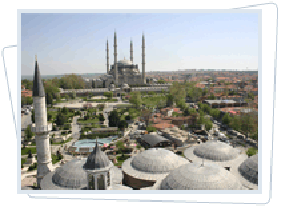European tourism Gardens of Eden no 4

Excellent European community tourism destinations selected by in country popular vote
Edirne (Turkey)
Selimye Mosque © Edirne
Edirne is just 225 km from Istanbul and one of the oldest settlements in Thrace and Anatolia. Dating back to the neolithic age 7.000-6.000 B.C. examples of prehistoric monuments – dolmens, menhirs and tumulus – can be seen from its outskirts.
The various historical names Edirne has had indicate the many historical periods it has been through. From Odrisia – founded by the Thracian civilisation Odryses in the 5th century B.C. – to Hadrianopolis – after Roman Emperor Hadrian who re-founded the city in the 2nd (123-124) century A.C., it was named Edrine by Sultan Murad I upon his conquest of the city in 1361. It kept this name until the 18th century when it became known as Edirne.
As the second largest capital of the Ottoman Empire, the city has a rich cultural heritage. The tradition of wrestling is big in Edirne and dates as far back as 1361 and the mosques, religious centres, bridges, bazaars, caravanserais and palaces, all make Edirne a living museum.
Edirne is a city of rivers – the Meriç, Arda and Tunca rivers all meet at Edirne and join the Ergene river in the south. Edirne has become famous for the historical bridges on these many rivers – Gazi Mihal bridge built in 1420 is the oldest and Uzunköprü bridge the longest (1 392 m long) with 174 arches.
As an economic and commercial centre, life in Edirne was rich and colourful and bazaars and caravanserais spread around the city. Four ancient bazaars are worth seeing: Bedesten, a covered bazaar where valuable goods and jewellery were sold, Arasta Bazaar, Ali Pasa Bazaar, the centre of commercial life in the 16-17th centuries with 129 shops, and Rüstempasa Caravanserai which was converted into a hotel in 1972.
Edirne is also famed for its mosques the most spectacular of which are:
- Selimiye mosque built by architect Sinan in the 16th (1569-1575) century is the focal point of the city at the top of a hill and is one of the greatest achievements of Ottoman architecture
- Eski mosque covered with nine domes is the oldest monumental Ottoman structure in Edirne dating back to the 15th (1403-1414) century
- Üç Serefeli mosque built in the 15th (144-1447) century is a typical Ottoman monument. Its dome was revolutionary at the time showing the succession between two architural periods – the early Ottoman and classic one.
Traditional handicrafts – brooms with mirrors, fruit soaps, Edirnekari and Edirne dolls – are exhibited for sale at handcraft shops.
Visitors can sample delicious local cuisine like white cheese, almond paste, fried liver, wrapped liver, Deva-i misk (a kind of halva) and Hardaliye (a drink produced mainly from grape juice mixed with mustard and marzipan).
A highlight of the city is the Kırkpınar wrestling event. Besides the wrestling contests, local cooking contests, various sport contests (swimming, archery, etc.), folklore demonstrations, exhibitions, and fairs are also organised.
Read more at: EDEN WEBSITE
Edirne Website: www.edirneint.bel.tr/en/for_english.htm
Video: WATCH
Sierra de las Nieves (Spain)
 View of Monda © Sierra de las Nieves
View of Monda © Sierra de las Nieves
Sierra de las Nieves is an unspoilt natural paradise lying in the central part of the province of Málaga. It forms a mountainous fringe that marks off the nearby western Costa del Sol. The nine main towns of the district – Alozaina, Casarabonela, El Burgo, Guaro, Istán, Monda, Ojén, Tolox and Yunquera – share a common natural, cultural and architectural heritage.
The district borders Costa del Sol, the Guadalhorce river valley (Valle del Guadalhorce), the Ronda Hills (Serranía de Ronda) and the district of Guadalteba, making it a strategic location well served by public transport.
In this rural and hilly district mankind still lives in perfect balance with nature. The nine main towns of Sierra de las Nieves are all knitted together by the whimsical twists and turns of the Sierra and still retain the rich tapestry of styles and cultures that have peopled this land.
In the heart of the district lies the Parque Natural (nature park) which boasts one of the world’s biggest Spanish fir woods, spanning over 3 000 hectares. The reserve also has one of Andalusia’s biggest populations of mountain goat.
The district is a place for adventurous leisure pursuits such as horse riding, canyoning, canoeing and kayaking, eco-routes in off-road vehicles, balloon trips, trekking and hiking.
Sustainable tourism is at the core of the tourism strategy in Sierra de las Nieves which aims to preserve natural and cultural heritage and enhance quality of life.
Ethnography is above all the star tourism product, uniting the whole district. Its core is the Ethnographic Encyclopaedia of the Sierra de las Nieves which compiles local folk wisdom.
Elderly people who act as tour guides keep the local history alive and play the role of ambassadors of cultural identity. Cultural mediators are also tasked with the responsibility of ensuring the quality of stays in each town.
Crafts and products may be discovered through thematic tours such as the local crop routes – the table olive harvest or the chestnut routes, the lime-gatherer or Calero route – one of the honoured crafts still living, and the pottery route starting at El Burgo’s pottery workshop. Other routes are the honey or the craftsmen routes as well as the cultural routes and outings to the towns of the district.
A variety of events, festivals and religious processions are also ways to discover local specificities:
the Festival de La Luna Mora in Guaro which goes back to medieval souks shows traditional Andalusian arts and practices and their Christians, Muslims and Sephardic Jewish influences
- the Festival Folclórico de Tolox with traditional song and dance
- the Castillo del Cante flamenco festival in Ojén
- the Mercado de Carboneros y Oficios Antiguos – Market of Charcoal Burners and Ancient Crafts – in Monda.
Read more at: EDEN WEBSITE
Sierra Nieves Website:www.sierranieves.com/eng/
Video: WATCH
The SoÄa Valley (Slovenia)
 Mountaineering – Soca Valley destination © Eric Cunder
Mountaineering – Soca Valley destination © Eric Cunder
The SoÄa valley is located in the easternmost part of the Julian Alps in north-west Slovenia. It brings together three municipalities: Bovec, Kobarid and Tolmin, covering an area of 942 km2.
The colourful valley is rich with waterfalls, pools, canyons, and flora and fauna. The legends in the air give it a fairy-tale atmosphere.
The SoÄa valley is a popular hub for natural scientists and botanists as well as home to the Juliana alpine botanical garden – the first alpine botanical garden in Slovenia.
This area is home to the legendary Goldhorn, a supernatural white chamois with golden horns, which has the power to restore its strength in nature. The SoÄa valley also prides itself on its genuine and diverse unspoiled landscape, bicycle trails and pathways throughout the year, and skiing facilities on the snow-covered Kanin slopes from where one can admire the sea.
The destination’s vital link and popular spot is the blue-green SoÄa river with picturesque gorges and wonderful streams, nearby waterfalls and verdant meadows. Paths lead to natural sites such as the great gorge of the SoÄa river by the SoÄa path, Tolminka gorge and the Kozjak waterfall.
Visitors can have active holidays and relaxation at the same time. The SoÄa valley offers water sports on the SoÄa river, hiking, cycling, skydiving, gliding, mountain biking, Alpine, Nordic and freestyle skiing and ski touring, fishing, climbing, mountaineering, potholing, golf, etc. Possibilities for adventure, peace and relaxation are unlimited. Guides are also on hand to help visitors experience and understand the nature, history and people.
Local culinary specialities in the SoÄa valley: compe and cottage cheese, frika, poštóklja and prepared SoÄa trout. Sweet dishes such as bulja, bovški krafi or kobariški štruklji are sure to enthral. Craftsmen sell characteristic local products made from wool, wax and SoÄa river pebbles.
The SoÄa river stories event is a two-day event at the end of April or beginning of May. The SoÄa river stories tell of World War I and its consequences on the valley, its population and everyone who went through rough times during the war. The event aims to turn this memory into a favourable event. It promotes cultural, ethnological and natural heritage, as well as peace.
The event which takes place at the Kluže fortress is based on a presentation of the life of soldiers of different nationalities and the local population during World War I. It helps visitors learn about and understand the history of the SoÄa Front (chronological, geographical and contextual definition, background, presentation of the different nations at war), and the everyday life of soldiers and locals.
On the first evening, memories of soldiers fighting on the SoÄa Front are read and on the second day visitors with guides wearing WWI uniforms take part in the Walks of Peace. Choir singing and the Dreizehn-dreizehn (1313) society provide entertainment at the event.
Read more at: EDEN WEBSITE
Soca Website: www.nadur.gov.mt/
Video: WATCH
Horezu Depression (Romania)

The Horezu depression combines five localities, namely Horezu town and its adjacent main villages, Costesti, Maldaresti, Vaideeni and Slatioara. It is located at the foot of the Capatânii mountains and sub-Carpathian area. Horezu is at the heart of the valley which characterises a community united in its linguistic, cultural and traditional features.
The valley has an exceptional cultural and natural patrimony which the area benefits from. From the tourist’s point of view, the valley is characterised by many peculiarities which grant this destination individuality and uniqueness. There are numerous natural monuments and as many as 93 cultural and historical monuments, enlisted by the Ministry of Culture.
The area’s natural geographic environment consists of a mountainous area covering nearly two thirds of its surface, woods, pastures, hay fields and orchards. The Capatânii mountains offers the highest peaks such as Ursu (2 124 m) and Cosana (2 011 m).
Orthodox Romanian heritage and culture marks the region. The Hurez monastery, a UNESCO monument, is one of the region’s symbols.
The diversity of the natural surroundings and historical buildings in the area is astounding and offers a wide array of possibilities to tourists. Among other religious monuments, the 500 years old Bistrita monastery housed the first printing press in Wallachia, and the first book ever to be printed on Romanian land in the 16th century. The Maldaresti fortified houses (Cule) are perfectly preserved fortified dwellings that served for defence during the medieval period. They offer a perspective of local architecture that dates back to medieval times. They are also rare sights of ethnography and folk art that can only be found in some localities.
Mineral springs in the Costesti village with therapeutic properties have been proved over time with a treatment base in the Costesti baths and balneoclimatic spa. The gorges of the Bistrita, Costesti and Pietreni are Romania’s narrowest and most impressive limestone gorges.
Shepherds long influenced the regional cuisine bringing together milk-based products (jintita, urda, balmos), and lamb and mutton-based products.
Several villages preserve traditional crafts and folklore – traditional costumes, weaving, embroidery, as well as the making of sheepskin coats, artistic woodwork, wool processing, architecture. Fairs and cultural events with choirs, whistle-players and folk dancers emphasise this ethno-cultural richness.
Read more at: EDEN WEBSITE
Horezu Website: www.horezuonline.ro/
Video: WATCH
SEE ALSO:
www.travelmole.com/stories/1147673.php
www.travelmole.com/stories/1147583.php
www.travelmole.com/stories/1147467.php
Valere Tjolle
Valere Tjolle is editor of the Sustainable Tourism Report Suite – special offers HERE
 United Kingdom
United Kingdom United States
United States Asia Pacific
Asia Pacific












































Dozens fall ill in P&O Cruises ship outbreak
Turkish Airlines flight in emergency landing after pilot dies
Boy falls to death on cruise ship
Unexpected wave rocks cruise ship
Storm Lilian travel chaos as bank holiday flights cancelled